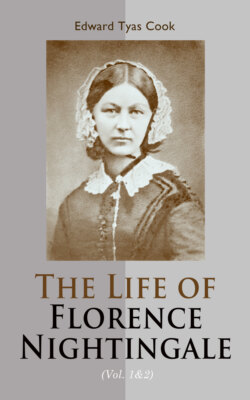Читать книгу The Life of Florence Nightingale (Vol. 1&2) - Edward Tyas Cook - Страница 36
IV
ОглавлениеHer mind was interested in all these things, but her heart was elsewhere. “Wherever thou art,” said a famous statesman, “it is with the poor that thou should'st live.” It was so with Florence Nightingale's inmost thoughts. Her greatest pleasure in Athens was found in the society of the American missionaries, Mr. and Mrs. Hill, who conducted a school and orphanage. Of Mrs. Hill she wrote, “From heaven she comes, in heaven she lives.” In charge of the mission school was a Greek refugee from Crete, Elizabeth Kontaxaki, and with her too Florence Nightingale formed a warm friendship. Elizabeth had lived an adventurous life before she found security at Athens. Her father had fallen by a Turkish bullet. Her mother had made an heroic escape from a Turkish captor, and the first years of the child's life were spent in the fastnesses of Mount Ida. “Alas,” wrote Miss Nightingale, “how worthless my life seems to me by the side of these women.” A mood of great dejection appears in her diary of this time, to which an attack of low-fever no doubt contributed. She could not find satisfaction in the interests of foreign travel. She was tortured by unsatisfied longings which could find outlet only in a world of dreams. An entry in her diary for June 7 is in these words: “Grotto of the Eumenides. Will this Fury go on increasing till by degrees my mind is more and more taken off the outer world with all its claims, and I am no longer able to command my attention at all?”
Miss Nightingale and her friends landed at Trieste at the end of June, and thence made their way to Dresden and Berlin. The pictures which most impressed her were Raphael's “Sistine Madonna” and the “Reading Magdalen,” then attributed to Correggio. A year later her mother and sister were at Dresden, and she enjoined them, above all things, to see “the Magdalen, the queen of pictures.” “How I feel that picture now,” she wrote to them (August 26, 1851), “dark wood behind, sharp stones in front, nothing to look back upon, nothing to look forward to, clinging to the present as she does to the book, which beams bright light upon me. Oh what a history that picture contains in its little canvass; and how well it hangs near that glorious Sistine Virgin. All that woman might be, all that she will be, near what she is; for it is not a Magdalen, in the common sense of the word, or rather it is in the common sense of what woman commonly is—not what we mean by a Magdalen.” At Dresden Miss Nightingale was still in much dejection. “I have never felt so bad,” she wrote (July 7); “the habit of living not in the present but in a future of dreams is gradually spreading over my whole existence. It is rapidly approaching the state of madness when dreams become realities.” And now when the goal of Kaiserswerth was near, she felt almost unmanned; almost inclined to turn back and follow another path. “It seemed to me now (July 10) as if quiet, with somebody to look for my coming back, was all I wanted.” But this was only a moment of passing weakness. At Berlin her spirits revived; for her vital interests were satisfied, and she spent some days in inspecting the hospitals and other benevolent institutions. On July 31 she reached Kaiserswerth. “I could hardly believe I was there,” she wrote in her diary. “With the feeling with which a pilgrim first looks on the Kedron, I saw the Rhine, dearer to me than the Nile.” She stayed a fortnight with the Pastor and his wife and the Deaconesses, studying their institutions. “Left Kaiserswerth,” says the diary (August 13), “feeling so brave as if nothing could ever vex me again.”46 She rejoined her friends at Düsseldorf. “They stayed at Ghent actually for me to finish my MS.” (August 17). “Finished my MS. They read it. Mr. Bracebridge corrected it and sent it off” (August 19). Next day they returned to England. The manuscript was of the pamphlet describing “The Institution of Kaiserswerth on the Rhine,” which was issued anonymously soon after Miss Nightingale's return.47 Some notice of the pamphlet will be found in a later chapter in connection with her longer sojourn at Kaiserswerth in 1851. It was printed by the inmates of the Ragged School at Westminster in which she was interested. She described in it the work of the Deaconesses, and ended with an appeal to Englishwomen to go and do likewise. The fire burnt within her, and she returned home more than ever resolved to consecrate her life to the service of the sick and sorrowful.
